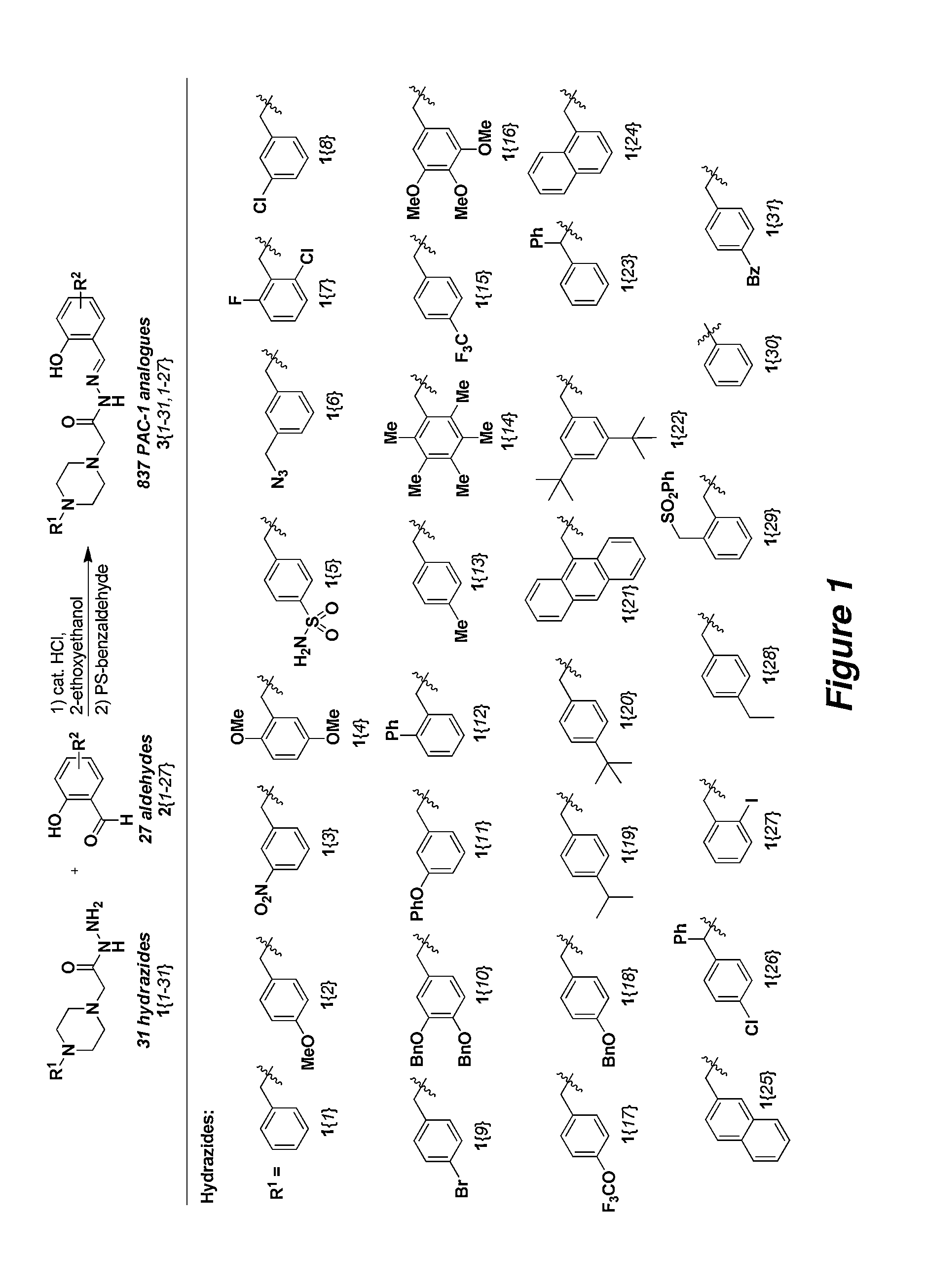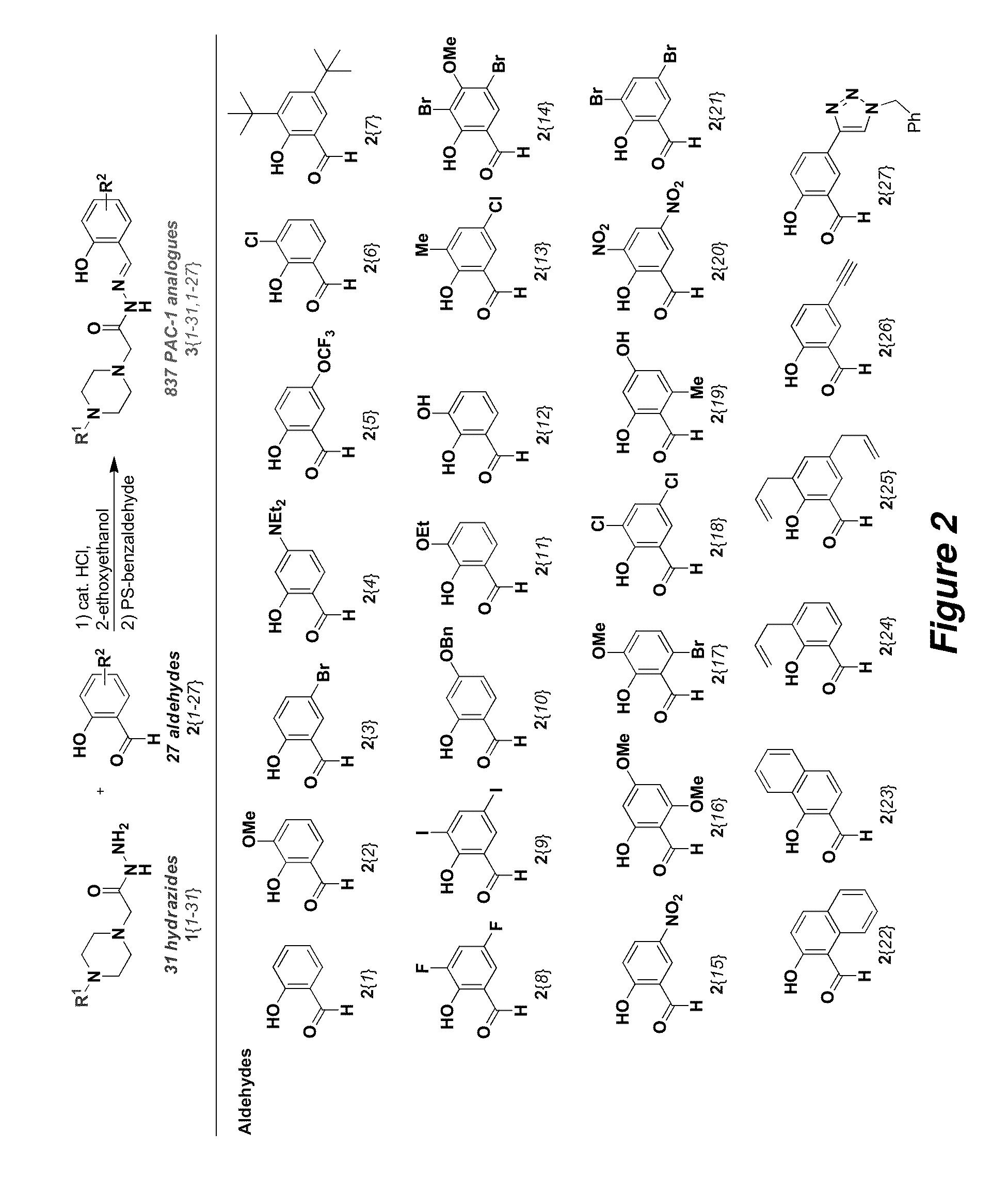Procaspase-activating compounds and compositions
a technology applied in the field of active compounds and compositions, to achieve the effect of reducing adverse reactions
- Summary
- Abstract
- Description
- Claims
- Application Information
AI Technical Summary
Benefits of technology
Problems solved by technology
Method used
Image
Examples
example 1
General Procedure for the Synthesis of PAC-1 Analogues
[0094]To a 16×150 mm test tube were added hydrazide (1.7 equiv), aldehyde (1.0 equiv), 2-ethoxyethanol (1 mL), and 1.2 M HCl (10 mol %). The tubes were shaken on a Biichi Syncore parallel synthesizer at 110° C. until all aldehyde had reacted (as monitored by ESI-MS). The reaction mixture was cooled to room temperature (˜23° C.), and polystyrene-benzaldehyde (3.5 equiv) was added. The reaction mixture was shaken at 25-80° C. until no hydrazide remained (as monitored by ESI-MS). The reaction mixture was cooled to room temperature, and the resin was filtered and washed with 2-ethoxyethanol. The filtrate was dried under high vacuum to afford the PAC-1 analogue.
example 2
Parallel Synthesis of 837 Analogues of PAC-1
[0095]Reactions requiring anhydrous conditions were conducted under a positive atmosphere of nitrogen or argon in oven-dried glassware. Standard syringe techniques were used for anhydrous addition of liquids. Unless otherwise noted, all starting materials, solvents, and reagents were acquired from commercial suppliers and used without further purification. Flash chromatography was performed using 230-400 mesh silica gel. Compounds 1{1}, 1{2}, 1{3}, 1{4}, 1{5}, 1{6}, 2{24}, 2{25}, 2{26}, and PAC-1 were synthesized as previously reported.
[0096]Compound Analysis.
[0097]NMR experiments were recorded either in CDCl3 (Sigma), CD3OD (Sigma) or (CD3)2O (Sigma) on a Varian Unity 400 MHz or 500 MHz spectrometer with residual undeuterated solvent as the internal reference for 1H-NMR and 13C-NMR experiments and 1% CFCl3 / CDCl3 as the external reference for 19F-NMR experiments. Chemical shift, δ (ppm); coupling constants, J (Hz); multiplicity (s=singlet,...
example 3
Biological Evaluation of 837 Analogues of PAC-1
[0269]Materials.
[0270]All reagents were obtained from Fisher unless otherwise indicated. All buffers were made with MilliQ purified water. Ac-DEVD-pNA was synthesized as previously described.5 Luria broth (LB) was obtained from EMD. Doxorubicin was obtained from Sigma. Caspase Activity Buffer contains 50 mM HEPES, 300 mM NaCl, 1.5 mM TCEP, 0.01% TritonX-100 and is Chelex® treated. Ni NTA Binding Buffer contains 50 mM Tris (pH 8.0), 300 mM NaCl, and 10 mM imidazole. Ni NTA Wash Buffer contains 50 mM Tris (pH 8.0), 300 mM NaCl, and 50 mM imidazole. Ni NTA Elution Buffer contains 50 mM Tris (pH 8.0), 300 mM NaCl, and 500 mM imidazole. Annexin V Binding Buffer contains 10 mM HEPES pH 7.4, 140 mM NaCl, 2.5 mM CaC12, 0.1% BSA. The C-terminal 6×His-tagged procaspase-3 proteins were expressed as described below.
[0271]Cell Culture.
[0272]U-937 cells were obtained from the American Type Culture Collection and maintained at low passage number. Cult...
PUM
| Property | Measurement | Unit |
|---|---|---|
| temperature | aaaaa | aaaaa |
| pH | aaaaa | aaaaa |
| pH | aaaaa | aaaaa |
Abstract
Description
Claims
Application Information
 Login to View More
Login to View More - R&D
- Intellectual Property
- Life Sciences
- Materials
- Tech Scout
- Unparalleled Data Quality
- Higher Quality Content
- 60% Fewer Hallucinations
Browse by: Latest US Patents, China's latest patents, Technical Efficacy Thesaurus, Application Domain, Technology Topic, Popular Technical Reports.
© 2025 PatSnap. All rights reserved.Legal|Privacy policy|Modern Slavery Act Transparency Statement|Sitemap|About US| Contact US: help@patsnap.com



